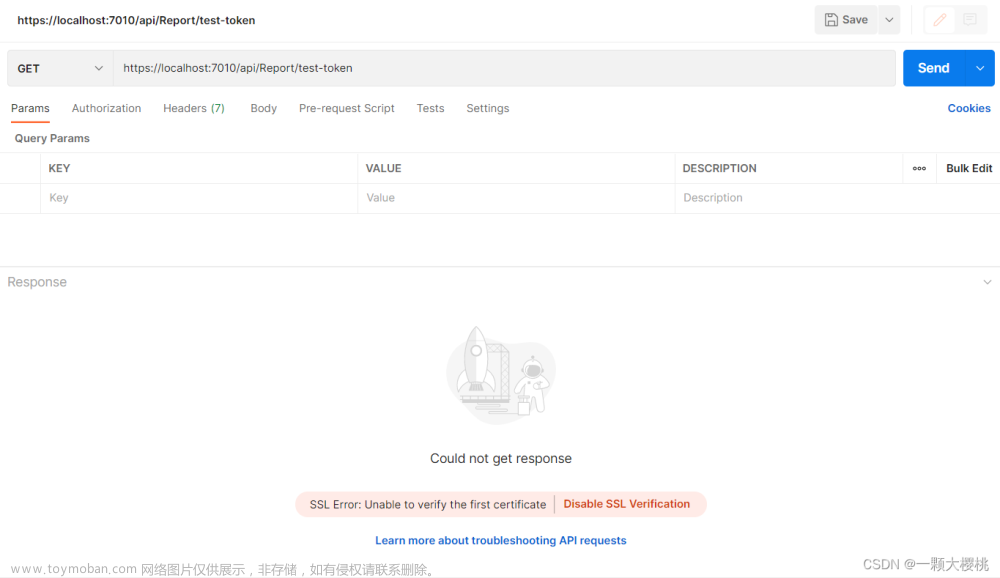提示信息:
审核失败!sun.security.validator.ValidatorException: PKIX path building failed: sun.security.provider.certpath.SunCertPathBuilderException: unable to find valid certification path to requested target executing POST 。。。 。。。
出现原因
这个问题的根本原因是你安装JDK时,Java\jar 1.8.0_141\lib\ext\里面缺少了一个安全凭证jssecacerts证书文件,通过运行下面类可以生成证书,将生成的证书放在Java\jar 1.8.0_141\lib\ext\这个目录下,重启编译器就可以解决。
解决方式有两种 第一种直接在发送请求的时候忽略掉http证书验证,第二种方式本地下载个证书
第一种:解决方式是在发送http请求的时候,可以过滤掉所有的https证书验证。
/**
* POST请求
*
* @param url
* @param data
* @return
*/
public String sendPost() {
LOG.info("send to tanggong : " + data);
String result = null;
CloseableHttpClient httpClient = HttpClients.createDefault();
//isNoSSL是否需要走特殊方法
if(isNoSSL)
{
httpClient = (CloseableHttpClient)wrapClient(httpClient);
}
HttpPost post = new HttpPost(httpUrl);
post.addHeader("Content-type","application/json; charset=utf-8");
post.setHeader("Accept", "application/json");
CloseableHttpResponse response = null;
try {
StringEntity sen = new StringEntity(data.toString(),Charset.forName("UTF-8"));
sen.setContentEncoding("UTF-8");
sen.setContentType("application/json");
post.setEntity(sen);
response = httpClient.execute(post);
if (response != null && response.getStatusLine().getStatusCode() == 200) {
HttpEntity entity = response.getEntity();
result = EntityUtils.toString(entity);
}
LOG.info("ZP return :" + result);
return result;
} catch (UnsupportedEncodingException e) {
e.printStackTrace();
} catch (ClientProtocolException e) {
e.printStackTrace();
} catch (IOException e) {
e.printStackTrace();
} finally {
try {
httpClient.close();
if (response != null) {
response.close();
}
} catch (IOException e) {
e.printStackTrace();
}
}
return null;
}
/**
* 避免HttpClient的”SSLPeerUnverifiedException: peer not authenticated”异常
* 不用导入SSL证书
* @param base
* @return
*/
public static HttpClient wrapClient(HttpClient base) {
try {
SSLContext ctx = SSLContext.getInstance("TLS");
X509TrustManager tm = new X509TrustManager() {
@Override
public void checkClientTrusted(java.security.cert.X509Certificate[] arg0, String arg1)
throws java.security.cert.CertificateException {
// TODO Auto-generated method stub
}
@Override
public void checkServerTrusted(java.security.cert.X509Certificate[] arg0, String arg1)
throws java.security.cert.CertificateException {
// TODO Auto-generated method stub
}
@Override
public java.security.cert.X509Certificate[] getAcceptedIssuers() {
// TODO Auto-generated method stub
return null;
}
};
ctx.init(null, new TrustManager[] { tm }, null);
SSLConnectionSocketFactory ssf = new SSLConnectionSocketFactory(ctx,NoopHostnameVerifier.INSTANCE);
CloseableHttpClient httpclient = HttpClients.custom().setSSLSocketFactory(ssf).build();
return httpclient;
} catch (Exception ex) {
ex.printStackTrace();
return HttpClients.createDefault();
}
} 第二种方式:
1、生成安全证书
2、放入jre相应路径下
生成安全证书
import java.io.*;
import java.net.URL;
import java.security.*;
import java.security.cert.*;
import javax.net.ssl.*;
public class InstallCert {
public static void main(String[] args) throws Exception {
String host;
int port;
char[] passphrase;
if ((args.length == 1) || (args.length == 2)) {
String[] c = args[0].split(":");
host = c[0];
port = (c.length == 1) ? 443 : Integer.parseInt(c[1]);
String p = (args.length == 1) ? "changeit" : args[1];
passphrase = p.toCharArray();
} else {
System.out.println("Usage: java InstallCert <host>[:port] [passphrase]");
return;
}
File file = new File("jssecacerts");
if (file.isFile() == false) {
char SEP = File.separatorChar;
File dir = new File(System.getProperty("java.home") + SEP
+ "lib" + SEP + "security");
file = new File(dir, "jssecacerts");
if (file.isFile() == false) {
file = new File(dir, "cacerts");
}
}
System.out.println("Loading KeyStore " + file + "...");
InputStream in = new FileInputStream(file);
KeyStore ks = KeyStore.getInstance(KeyStore.getDefaultType());
ks.load(in, passphrase);
in.close();
SSLContext context = SSLContext.getInstance("TLS");
TrustManagerFactory tmf =
TrustManagerFactory.getInstance(TrustManagerFactory.getDefaultAlgorithm());
tmf.init(ks);
X509TrustManager defaultTrustManager = (X509TrustManager)tmf.getTrustManagers()[0];
SavingTrustManager tm = new SavingTrustManager(defaultTrustManager);
context.init(null, new TrustManager[] {tm}, null);
SSLSocketFactory factory = context.getSocketFactory();
System.out.println("Opening connection to " + host + ":" + port + "...");
SSLSocket socket = (SSLSocket)factory.createSocket(host, port);
socket.setSoTimeout(10000);
try {
System.out.println("Starting SSL handshake...");
socket.startHandshake();
socket.close();
System.out.println();
System.out.println("No errors, certificate is already trusted");
} catch (SSLException e) {
System.out.println();
e.printStackTrace(System.out);
}
X509Certificate[] chain = tm.chain;
if (chain == null) {
System.out.println("Could not obtain server certificate chain");
return;
}
BufferedReader reader =
new BufferedReader(new InputStreamReader(System.in));
System.out.println();
System.out.println("Server sent " + chain.length + " certificate(s):");
System.out.println();
MessageDigest sha1 = MessageDigest.getInstance("SHA1");
MessageDigest md5 = MessageDigest.getInstance("MD5");
for (int i = 0; i < chain.length; i++) {
X509Certificate cert = chain[i];
System.out.println
(" " + (i + 1) + " Subject " + cert.getSubjectDN());
System.out.println(" Issuer " + cert.getIssuerDN());
sha1.update(cert.getEncoded());
System.out.println(" sha1 " + toHexString(sha1.digest()));
md5.update(cert.getEncoded());
System.out.println(" md5 " + toHexString(md5.digest()));
System.out.println();
}
System.out.println("Enter certificate to add to trusted keystore or 'q' to quit: [1]");
String line = reader.readLine().trim();
int k;
try {
k = (line.length() == 0) ? 0 : Integer.parseInt(line) - 1;
} catch (NumberFormatException e) {
System.out.println("KeyStore not changed");
return;
}
X509Certificate cert = chain[k];
String alias = host + "-" + (k + 1);
ks.setCertificateEntry(alias, cert);
OutputStream out = new FileOutputStream("jssecacerts");
ks.store(out, passphrase);
out.close();
System.out.println();
System.out.println(cert);
System.out.println();
System.out.println
("Added certificate to keystore 'jssecacerts' using alias '"
+ alias + "'");
}
private static final char[] HEXDIGITS = "0123456789abcdef".toCharArray();
private static String toHexString(byte[] bytes) {
StringBuilder sb = new StringBuilder(bytes.length * 3);
for (int b : bytes) {
b &= 0xff;
sb.append(HEXDIGITS[b >> 4]);
sb.append(HEXDIGITS[b & 15]);
sb.append(' ');
}
return sb.toString();
}
private static class SavingTrustManager implements X509TrustManager {
private final X509TrustManager tm;
private X509Certificate[] chain;
SavingTrustManager(X509TrustManager tm) {
this.tm = tm;
}
public X509Certificate[] getAcceptedIssuers() {
throw new UnsupportedOperationException();
}
public void checkClientTrusted(X509Certificate[] chain, String authType)
throws CertificateException {
throw new UnsupportedOperationException();
}
public void checkServerTrusted(X509Certificate[] chain, String authType)
throws CertificateException {
this.chain = chain;
tm.checkServerTrusted(chain, authType);
}
}
}D:\桌面\ 。。。\src\main\java\com\ideal\sk>java InstallCert 需要访问的地址:端口
或者设置idea 运行的args参数
执行完后会出现这样的界面
直接输入1,然后会在相应的目录下产生一个名为‘jssecacerts’的证书
将证书copy到$JAVA_HOME/jre/lib/security目录下文章来源:https://www.toymoban.com/news/detail-776312.html
重启程序即可解决文章来源地址https://www.toymoban.com/news/detail-776312.html
到了这里,关于报错 unable to find valid certification path to requested target executing的文章就介绍完了。如果您还想了解更多内容,请在右上角搜索TOY模板网以前的文章或继续浏览下面的相关文章,希望大家以后多多支持TOY模板网!

![sqlmap报错[CRITICAL] unable to connect to the target URL. sqlmap is going to retry the request(s)](https://imgs.yssmx.com/Uploads/2024/02/659387-1.png)









